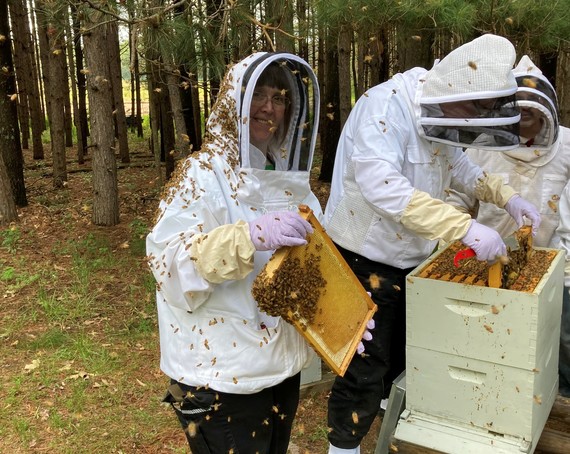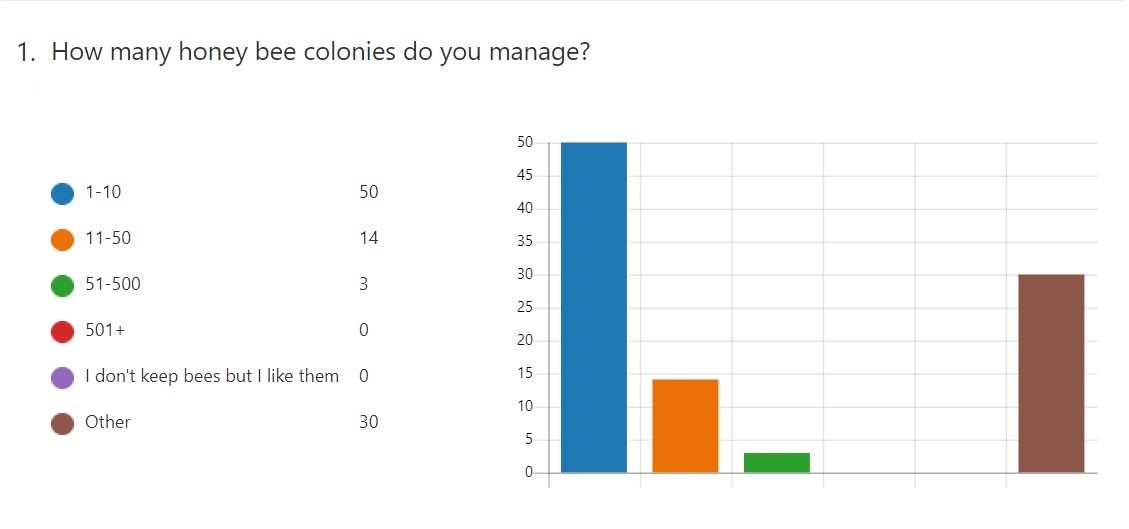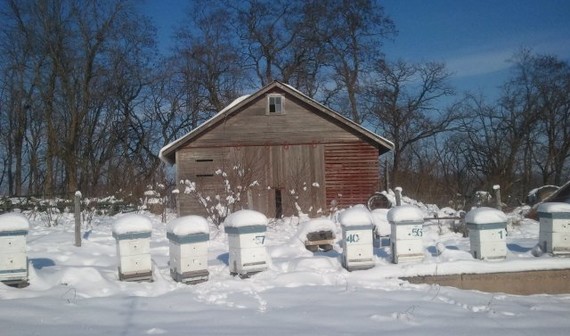
Dear Wisconsin beekeepers and those interested in honey bees and wild pollinators:
This is the first issue of what we hope will become a regular, quarterly update from the Wisconsin Department of Agriculture, Trade and Consumer Protection’s (DATCP) apiary program. Please let us know how you enjoy this e-news, and send any feedback, questions, or ideas for future updates to Frances.Hegarty@wisconsin.gov.
The DATCP Beekeeping and Pollinators webpage contains links to webpages for the DATCP Apiary Program and the Wisconsin Pollinator Protection Plan.
 DATCP apiary inspector Donna Stine and others performing an inspection.
DATCP supports Wisconsin beekeepers, honey bees and wild pollinators through our Apiary Program services. Field work in 2021 included 287 inspections with inspectors opening 2,266 hives. This includes migratory inspections conducted for beekeepers in the fall, which enabled them to transport bees to other states for crop pollination. Twenty-four USDA bee survey samples were also collected to ensure that new pests and diseases are not threatening colonies.
The Apiary Program also provides outreach to ensure apiary import requirements are met, sound hive management is practiced, and actions are taken to protect pollinators. For the past 15 years, Liz Meils has led our Apiary Program as our state apiarist. In this role Liz recruited and trained seasonal inspectors, issued apiary inspection certificates, devised apiary compliance protocols, conducted apiary outreach, oversaw the creation of Wisconsin’s Pollinator Protection Plan, and expanded Apiary Program support through various grants. She did this while also serving as the nursery program coordinator and a nursery inspector.
In 2022, we rearranged bureau staffing to welcome Frances Hegarty, a new full-time coordinator to accommodate vast increases in requests for apiary inspections and outreach. Hegarty has worked in DATCP’s Plant Industry Bureau since 2016, and her background includes program coordination, licensing, landscape architecture, and urban forestry. Over the coming months, Frances will transition into her new role as state apiarist with Liz and our two seasonal inspectors who joined DATCP in 2021 -- Patrick Sizemore, who covers western Wisconsin, and Donna Stine, who covers the eastern half of the state. We hope these program changes will allow us to amplify Apiary Program work to improve honey bee and wild pollinator health. Please welcome Frances, Donna, and Patrick in their new roles!
 The Wisconsin Beekeeper Survey that many of you have taken over the past two years is an important tool the Apiary Program has used to understand the needs of the beekeeping community. Thank you for taking this survey.
The survey contained questions about your bees, beekeeping, and how the Apiary Program serves as a resource to beekeepers. The Apiary Program used your survey responses to measure our progress, successes, and areas of potential improvement. Those who decided to share their contact information at the end of the survey should expect a follow-up phone call from Apiary Program staff soon. During this conversation, which should take about 20 minutes, we will ask you questions related to how our outreach impacted your hive management practices. We greatly appreciate your time and input.
-
97 respondents took the survey between March 2020 and November 2021. Most (52%) were hobbyist, 14% could be considered sideliners, and 3% were commercial beekeepers. Some respondents indicated that they were interested in beekeeping but had not started. It seems that a significant number beekeepers who took the survey are relatively new and could benefit from our outreach.
-
86% raise bees for honey vs. 44% using their bees for pollination, queen-rearing, or other purposes.
-
96% learned something new about bee management because of DATCP’s outreach efforts.
-
58% had no management plan at the time of the survey, but 85% indicated that information provided by DATCP's apiary staff will help improve or create management plans.
-
34% were not aware of DATCP inspection services before the survey, and 70% indicated that they had never received an inspection from Apiary Program staff. See our website for more information about this inspection service, which is available on a first-come, first-served basis, May-October.
-
86% of respondents did not need or did not have trouble finding a veterinarian or getting a prescription if they used antibiotics to treat a disease.
The most common request for more information was about winterizing hives and improving overwintering colony survival. Please see the next section of this email for more information about overwintering.
 Honey bee colonies overwintering in Wisconsin.
Successful overwintering of honey bees in Wisconsin can be complicated and impacted by various factors, not just our cold Wisconsin winters. Previous scientific studies have found strong correlations (mutual relationship or connection between two or more things) between winter colony loss and levels of Varroa mites, the viruses they vector, geographic location, and genotype of the honey bees. There has not yet been enough scientific research on each of these variables (Varroa mites, viruses, location, etc.) to know exactly how each variable influences overwintering success. There are many “do’s” and “don’ts” when it comes to successfully overwintering your bees in Wisconsin.
Here are some of the things you should do.
Overwinter healthy colonies.
- Assess the health of each colony prior to winter.
- Only overwinter colonies with large populations of workers and abundant food stores.
- Combine small, healthy colonies.
- Replace weak queens.
Monitor and control for Varroa mites using Integrated Pest Management (IPM) tactics.
Follow pesticide labels, and remember, “The Label is the Law.”
- Report pesticide misuse to DATCP at (608) 224-4529 or DATCPpesticideinfo@wisconsin.gov.
- See DATCP pesticide complaints webpage for more information about reporting pesticide misuse in Wisconsin.
- Check our website each year for a list of approved honey bee treatments.
Insulate and ventilate each hive and, if appropriate, provide a windbreak.
- Keep each hive behind a windbreak or move them inside a shed or barn for the winter.
- Make sure each hive has the ability to ventilate out excess moisture.
- Add ventilation near the top of the hive to reduce condensation.
Add an entrance reducer or mouse guard in the fall.
 Honey bee colonies being loaded onto a truck for transport.
The DATCP Apiary Program is tasked with monitoring bees coming into the state as well as those leaving the state to help prevent the spread of unwanted honey bee pests and diseases. One way we can track bees coming and going is with the Honey Bee Import Requirement.
Wis. Stat. § 94.76(4) requires any person who brings, or causes to be brought into this state, any honey bee to report the shipment to the department. Wis. Admin. Code § ATCP 21.13(1)(a) states that “No person may ship live honey bees or used beekeeping equipment into this state without first reporting the import shipment to the department in writing.”
The requirements are straightforward: The beekeeper (or farmer, if bringing in bees for pollination services) must report the shipment to DATCP prior to the bees’ arrival into Wisconsin. There is no fee to the beekeeper or the farmer for filing the import report. The import report form is available online at: https://tinyurl.com/WI-HBIR. In addition to completing the import report form, provide a valid apiary inspection certificate issued within the last 12 months, and send only European honey bee stock, apparently free of American foulbrood.
More information on the requirements for honey bee colonies entering Wisconsin can be found on the DATCP Moving Bees Into Wisconsin webpage. You can also print a PDF of the import report form. If you have filed a Honey Bee Import Report with us in the past or shipped bees out of Wisconsin for overwintering or pollination services, watch your mail and email soon for reminders to submit your 2022 form.
Find more information about the DATCP Apiary Program and the Wisconsin Pollinator Protection Plan via the DATCP Beekeeping and Pollinators webpage.
Division of Agricultural Resource Management | Bureau of Plant Industry
Having trouble viewing this email? View it as a Web page.
|